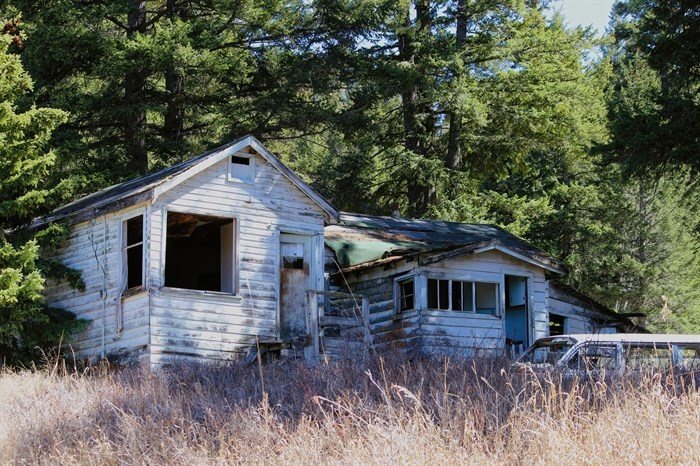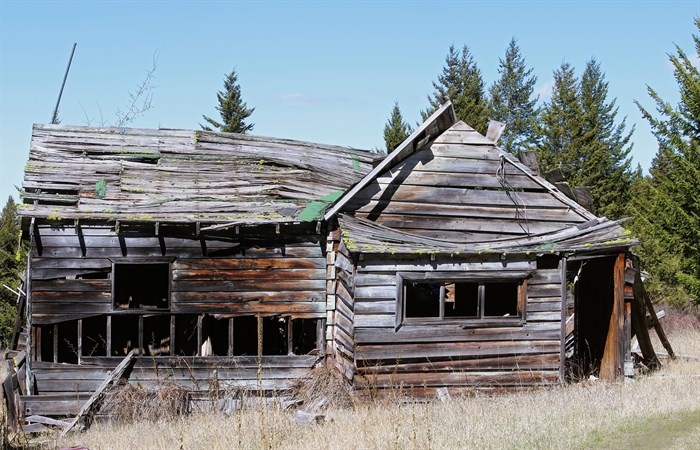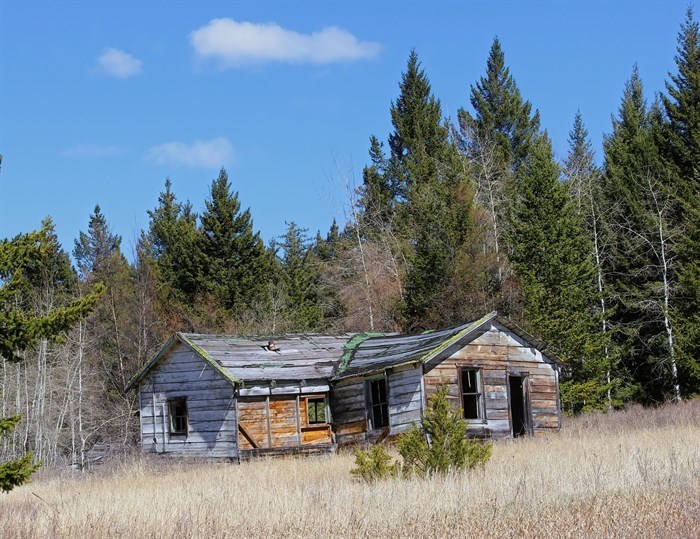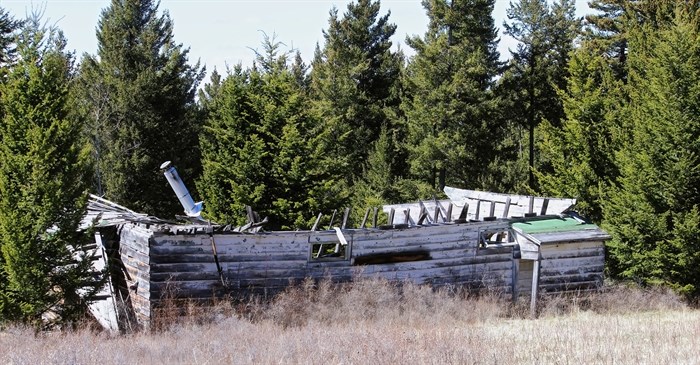
This is house at Trapp Lake near Kamloops that once housed the supervisor's family of a sawmill camp.
Image Credit: SUBMITTED/ Darrel Frolek
June 08, 2024 - 7:00 AM
This spring avid outdoor enthusiast Darrel Frolek hiked for an hour through the bush near Trapp Lake to photograph the decaying remains of a sawmill site he lived at seven decades ago.
The dilapidated houses and a one-room school house falling into rubble brought back memories for Frolek, 78, of a difficult and much different time long ago. While he was too young to remember the details of the year he spent going to school there, it was a year that altered his family’s life forever.
“I took my time walking around the buildings, reflecting on what it once was,” he said. “I sort of remember bits and pieces, I was only seven. The last time I saw it was 50 years ago, now the buildings are getting grown over by trees.”
Frolek went to live at the camp when his mother contracted polio in June of 1953. She was taken to Vancouver General Hospital and put in an iron lung where she spent many months fighting for her life.
“She was 29 and a vibrant young woman, then she got very sick, so much was taken away from her,” he said.
He was sent to live at his uncle’s lumber camp to attend school from September 1953 to June 1954. His father stayed at a house in a nearby valley raising Frolek’s little sisters.

This decaying structure at Trapp Lake once housed a family who worked at a sawmill camp in the 1950s.
Image Credit: SUBMITTED/ Darrel Frolek
His uncle built the lumber camp in the 1940s to house the workers that worked at his sawmill.
“At the time there were roughly 10 houses on the site and a small work crew, I boarded with my uncle’s supervisor’s family. In those days they had gyppo mills in the bush and you moved your sawmill around to the areas you’re going to log. There was an eight person crew that included a sawyer, the fallers and one who dragged the logs in.”
Details of the time he spent at the camp are not clear for Frolek, however, he remembered which house he spent time in. He's clear about the impact polio had on his family.
“It’s sad she came down with a major case of polio, it changed the family for the rest of the year and beyond. She later told me she was in so much pain she was almost unconscious and she overheard a doctor say she wasn’t going to live. She decided then to get committed to get better for her three children.”
READ MORE: iN PHOTOS: Avid Vernon hiker captures spectacular scenes in Kamloops, Okanagan
Vaccines for the polio virus came out the year after Frolek’s mother came home and he and his siblings were taken for the vaccine.
“She was in pain post polio and lost her ability to swallow,” he said. “It took a long time with a friend spooning feeding her to get the ability back but it was never perfect and she risked choking on food for the rest of her life.”

The remains of a family house can be seen at Trapp Lake near Kamloops.
Image Credit: SUBMITTED/ Darrel Frolek
The sawmill camp was the last camp Frolek’s uncle built and it was shut down in the 1960s. Most of the buildings have collapsed over time and no other evidence of the sawmill remains.
He captured images of what is left of the family homes and the school house. He isn’t disclosing the exact location of the site.
READ MORE: May was rainy in Okanagan, Kamloops but not rainy enough to impact drought
“I’m getting older now, I’m slowing down, so it might be the last time I see it. If a wildfire goes through it will all be gone," he said.
“Being there took me back and I reflected on how that year changed our lives and how people lived back then in a rural camp. In the end, we all made it through.”

These remains are of a one-room schoolhouse that operated in the 1950s at Trapp Lake near Kamloops.
Image Credit: SUBMITTED/ Darrel Frolek
The term “gyppo logging” refers to timber harvesting done by small, independently owned companies that relied on contracts with larger timber companies and sawmills, according to Oregon Encyclopedia.
READ MORE: iN PHOTOS: Gems along Kettle Valley Rail Trail from Myra Canyon to Chute Lake
In the early 1930s bulldozers were constructing more gravel roads for heavy-duty logging trucks. Increasing technology of the logging trucks like better braking systems and diesel power allowed for a shift away from expensive railroad logging. More opportunities for logging on steeper, remote terrain opened up for smaller logging companies who would assume the many safety and operational risks involved.
“During the Depression and continuing into the 1950s, some gyppo operators even ran small, portable sawmills capable of producing rough lumber or specialty items such as shakes, shingles, railroad ties, or box and barrel materials," the article read.
To contact a reporter for this story, email Shannon Ainslie or call 250-819-6089 or email the editor. You can also submit photos, videos or news tips to the newsroom and be entered to win a monthly prize draw.
We welcome your comments and opinions on our stories but play nice. We won't censor or delete comments unless they contain off-topic statements or links, unnecessary vulgarity, false facts, spam or obviously fake profiles. If you have any concerns about what you see in comments, email the editor in the link above. SUBSCRIBE to our awesome newsletter here.
News from © iNFOnews, 2024